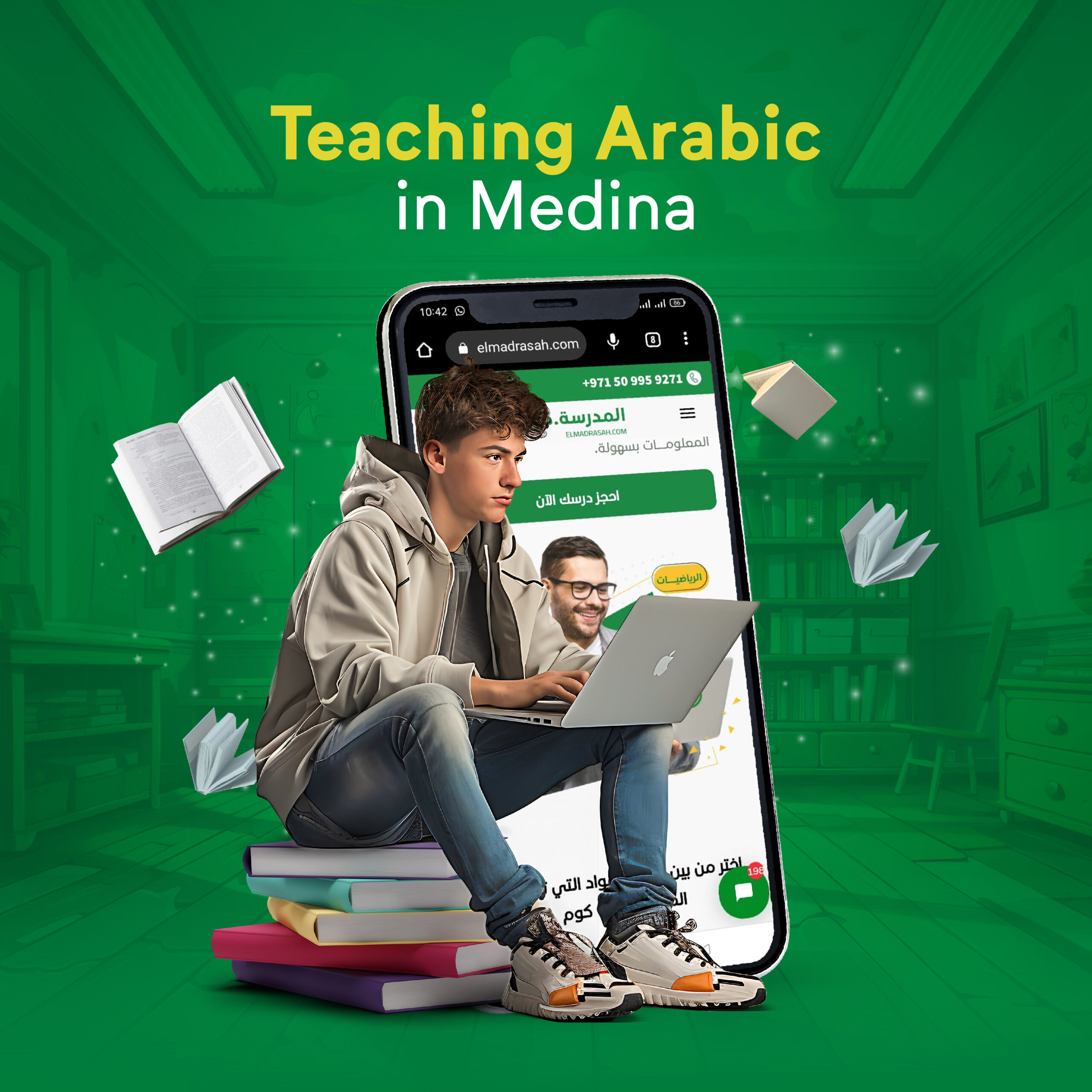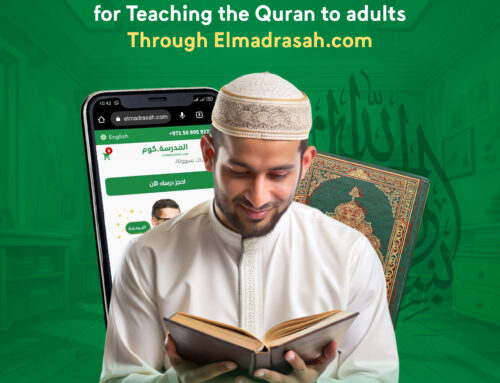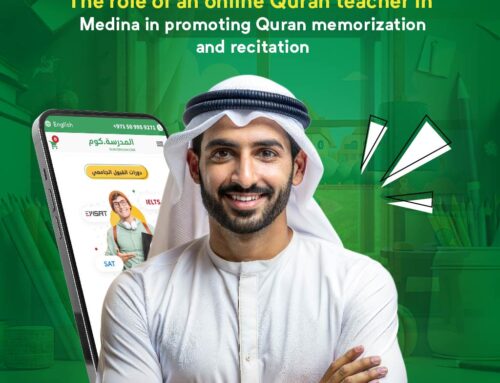
Teaching Arabic in Medina has been a cornerstone of preserving and promoting the Arab world’s language and culture for centuries. This historic city, steeped in religious and cultural significance, has attracted scholars and learners for ages, making it a prime location for Arabic language instruction. More than just language lessons, teaching Arabic in Medina aims to cultivate a profound connection to Arabic culture and Islamic traditions.
The Significance of Teaching Arabic in Medina
Medina’s historical and religious prominence makes it a prime location for promoting the Arabic language. As the second holiest city in Islam, it holds a special place in the hearts of Muslims globally. Teaching Arabic in Medina, therefore, is not just about language proficiency; it is about instilling a deeper appreciation for Islamic teachings and Arab culture. Understanding the Arabic language allows individuals to engage with religious texts and appreciate the rich cultural heritage tied to the language.
The importance of spreading the Arabic language extends far beyond the borders of Medina. Arabic is one of the most widely spoken languages in the world, with over 400 million speakers across 22 countries. However, its significance lies not just in its numbers but in its cultural and religious relevance. Learning Arabic opens doors to understanding the Quran, the Hadiths, and a treasure trove of Islamic scholarship. Therefore, the steps taken to teach Arabic in Medina are closely tied to promoting a broader understanding of Islam and Arab civilization.
Historical Context of Arabic Language Instruction in Medina
Arabic language instruction in Medina has deep roots that trace back to the early days of Islam. The Prophet Muhammad (peace be upon him) emphasized the importance of learning and understanding Arabic to connect with the Quran. Throughout Islamic history, Medina has been a center for religious and linguistic scholarship. Scholars from all over the world traveled to Medina to learn Arabic, as mastering the language was seen as essential for understanding the Quran and Hadiths in their original form.
Over time, Medina’s reputation as a center for Arabic learning solidified. The city became home to some of the most prestigious Islamic institutions, where both religious and linguistic education was offered. While the primary focus was on teaching Arabic to Muslims, the city’s institutions also began welcoming non-Muslims interested in the language and culture. This openness has been instrumental in promoting intercultural communication and understanding.
Modern Approaches to Teaching Arabic in Medina
While traditional methods of teaching Arabic in Medina remain highly respected, modern approaches have been incorporated to meet the demands of contemporary learners. These approaches recognize that students come from diverse backgrounds, each with their unique motivations for learning Arabic. As a result, teaching Arabic in Medina now combines classical methods with contemporary techniques to cater to a global audience.
Immersive Learning Environment
One of the key factors that make teaching Arabic in Medina so effective is the immersive environment. In Medina, students are surrounded by Arabic in their daily interactions. Whether they are attending religious lectures, reading signs, or conversing with locals, Arabic is omnipresent. This immersion significantly accelerates the learning process, as students are constantly exposed to both the written and spoken language.
Immersive learning is not limited to Medina’s physical environment. Institutions in the city have embraced digital tools to create virtual immersion experiences. Online platforms like Elmadrasah.com allow students to engage in immersive learning from anywhere in the world. These platforms provide live lessons with native Arabic speakers, interactive exercises, and cultural content that brings Medina’s learning environment into the homes of learners across the globe.
Structured Language Programs
To ensure that learners receive a comprehensive education, teaching Arabic in Medina often follows a structured program that covers all aspects of the language. These programs are designed to take students from beginner to advanced levels, with a focus on reading, writing, speaking, and listening skills. Medina’s institutions often integrate religious and cultural studies into their language programs, ensuring that students not only learn the language but also gain an understanding of its cultural context.
The inclusion of cultural studies is an essential aspect of teaching Arabic in Medina. The language cannot be separated from the culture, and by teaching the two together, students gain a holistic understanding of Arabic. The structured programs offered by Medina-based institutions and online platforms like Elmadrasah.com reflect this integration of language and culture, offering learners a well-rounded educational experience.
Teacher-Student Interaction
One of the cornerstones of effective language instruction is the interaction between teachers and students. In Medina, teaching Arabic often involves close, one-on-one interactions between students and their instructors. This personalized approach ensures that each student’s unique needs are addressed, whether they are struggling with grammar or pronunciation. Teachers in Medina are often native Arabic speakers with extensive knowledge of both the language and Islamic teachings, making them uniquely qualified to teach students from diverse backgrounds.
Online platforms have also adapted this approach, offering personalized lessons through video calls, forums, and real-time feedback. Elmadrasah.com, for example, connects students with native Arabic instructors who provide tailored lessons based on the student’s proficiency level and learning goals. This direct interaction is crucial for language acquisition, as it allows students to ask questions, practice speaking, and receive immediate feedback on their progress.
Cultural Integration: Enhancing the Learning Experience
Teaching Arabic in Medina is not just about linguistic proficiency; it is also about promoting cultural understanding. The Arabic language is deeply intertwined with Arab culture, and learning the language provides insights into the customs, values, and traditions of Arab societies. In Medina, this cultural integration is an integral part of the language learning experience.
Cultural Immersion in Medina
Living in Medina provides learners with a unique opportunity to experience Arab culture firsthand. Students can immerse themselves in the daily life of the city, observing local customs, tasting traditional foods, and participating in religious events. This immersion helps students understand the cultural context in which the Arabic language is used, making it easier for them to grasp nuances and idiomatic expressions that may not be evident from textbooks alone.
Cultural immersion is not limited to Medina’s residents. Elmadrasah.com and other online platforms have created virtual cultural immersion experiences for students who cannot physically travel to the city. Through videos, articles, and interactive content, learners can explore the customs, traditions, and values of Arab culture from the comfort of their homes. This virtual immersion helps students feel more connected to the language and its cultural roots, even if they are thousands of miles away from Medina.
Promoting Cultural Communication Through Arabic
Teaching Arabic in Medina plays a vital role in promoting cultural communication between the Arab world and the rest of the globe. Arabic is a language of diplomacy, commerce, and education in many parts of the world. By learning Arabic, individuals can engage more effectively in cross-cultural communication, fostering mutual understanding and respect between different societies.
Medina’s institutions and platforms like Elmadrasah.com recognize the importance of cultural communication in today’s interconnected world. They emphasize the role of Arabic as a bridge between cultures, encouraging students to use their language skills to engage with people from diverse backgrounds. This focus on cultural communication is essential for building global connections and promoting peaceful coexistence in an increasingly multicultural world.
The Role of Elmadrasah.com in Expanding Access to Arabic Education
In recent years, online platforms have revolutionized the way Arabic is taught and learned. These platforms have made teaching Arabic in Medina accessible to a global audience, breaking down geographical barriers and providing learners with the tools they need to succeed. Elmadrasah.com, in particular, has been instrumental in expanding access to Arabic education by offering high-quality language courses that are flexible, affordable, and interactive.
Online Learning Tools
One of the biggest advantages of online platforms is the wide range of learning tools they offer. Elmadrasah.com, for instance, provides learners with interactive exercises, quizzes, and multimedia content that make learning Arabic engaging and enjoyable. These tools cater to different learning styles, ensuring that students can find methods that work best for them. Whether a student prefers visual, auditory, or kinesthetic learning, online platforms have resources to support their needs.
Flexibility and Accessibility
Another significant benefit of online platforms like Elmadrasah.com is the flexibility they offer. Students can learn at their own pace and on their own schedule, making it easier for busy professionals, students, and parents to fit Arabic lessons into their daily lives. This flexibility is particularly valuable for learners who may not have the time or resources to travel to Medina for in-person instruction.
In addition to flexibility, online platforms make teaching Arabic in Medina accessible to learners from all over the world. Whether a student is in Europe, Asia, or the Americas, they can access high-quality Arabic lessons with just a few clicks. This global reach has helped Medina’s reputation as a center for Arabic education extend far beyond its physical borders, allowing more people to benefit from the city’s rich linguistic and cultural heritage.
Challenges and Solutions in Teaching Arabic in Medina
While Medina’s institutions and online platforms have made significant strides in promoting the Arabic language, there are still challenges to overcome. One of the main challenges is the diverse backgrounds of students. Learners come from different countries, speak various languages, and have varying levels of proficiency in Arabic. This diversity can make it difficult to create a one-size-fits-all approach to teaching.
To address this challenge, Medina’s institutions and platforms like Elmadrasah.com have adopted personalized learning models. These models assess each student’s proficiency level, learning style, and goals, and tailor lessons accordingly. By providing individualized instruction, these institutions ensure that students receive the support they need to succeed, regardless of their background.
Another challenge is the complexity of the Arabic language itself. Arabic has a rich grammatical structure and a vast vocabulary, which can be overwhelming for beginners. To help students navigate these complexities, instructors in Medina and on online platforms break down the language into manageable components, focusing on building a strong foundation in grammar, vocabulary, and pronunciation before moving on to more advanced topics.
Expanding Arabic Language Programs in Medina: The Path Forward
As we look to the future of teaching Arabic in Medina, it’s crucial to recognize the ongoing development of language programs, institutions, and online platforms that continuously refine the learning process. The city’s tradition of scholarship is evolving to meet the demands of a global audience eager to grasp both the intricacies of the Arabic language and its cultural context. Teaching Arabic in Medina remains an exceptional endeavor, not only because of its historical and religious significance but also due to the innovative approaches now in place to foster deeper, more meaningful learning.
The Role of Educational Institutions in Promoting Arabic
Teaching Arabic in Medina continues to thrive through the prestigious institutions that have been operating for decades. These institutions are well-respected not only for their focus on religious studies but also for the comprehensive Arabic language programs they offer. Many of these institutions have embraced modern pedagogical techniques, integrating technology into their teaching methods to enhance the learning experience.
Some of these schools focus on Arabic literature, poetry, and historical texts to give learners a deep dive into the richness of the language. This helps students engage with the language on a literary level, allowing them to appreciate the nuances of classical Arabic while developing a solid foundation for understanding contemporary Arabic. At the same time, language programs in Medina also incorporate practical language skills for everyday use, making sure that students are well-rounded in their knowledge.
Through these institutions, teaching Arabic in Medina has become a beacon of educational excellence that bridges traditional and contemporary teaching methods. These schools serve as a model for how to promote language learning in other cities, using Medina’s unique historical and cultural backdrop as a core component of the learning process.
Building Global Connections Through Arabic
The emphasis on cultural communication through Arabic continues to grow, particularly in light of the increasing importance of the language in diplomacy, international business, and cultural exchange. Teaching Arabic in Medina equips learners with the linguistic tools necessary to engage in meaningful conversations that transcend cultural barriers. As Arabic is spoken by millions of people around the world, learning the language can open doors to new opportunities in various sectors such as trade, education, and government.
With institutions and platforms like Elmadrasah.com leading the charge, Medina’s approach to teaching Arabic encourages learners to use their skills to create global connections. By learning Arabic in Medina, students are not just mastering the grammar and vocabulary—they are also gaining insight into how the language functions within different contexts, whether they are professional, religious, or social. This fosters a greater appreciation for the role of Arabic in connecting people from diverse backgrounds.
Conclusion:
The efforts to teach Arabic in Medina have had a profound impact on both the city and the global community. As a center of religious and linguistic scholarship, Medina continues to attract learners from all over the world who are eager to master the Arabic language and deepen their understanding of Arab culture. Through a combination of traditional teaching methods, modern technology, and immersive learning experiences, Medina remains a leading force in promoting the Arabic language and fostering cultural communication.















